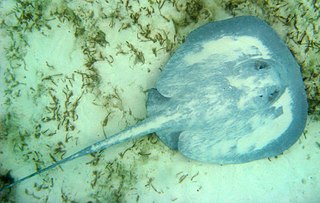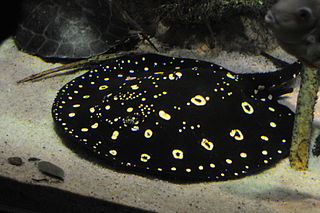
River stingrays or freshwater stingrays are Neotropical freshwater fishes of the family Potamotrygonidae in the order Myliobatiformes, one of the four orders of batoids, cartilaginous fishes related to sharks. They are found in rivers in tropical and subtropical South America. A single marine genus, Styracura, of the tropical West Atlantic and East Pacific are also part of Potamotrygonidae. They are generally brownish, greyish or black, often with a mottled, speckled or spotted pattern, have disc widths ranging from 31 to 200 centimetres (1.0–6.6 ft) and venomous tail stingers. River stingrays feed on a wide range of smaller animals and the females give birth to live young. There are more than 35 species in five genera.

The ocellate river stingray, also known as the peacock-eye stingray or black river stingray, is a species of freshwater stingray in the family Potamotrygonidae. It was the first species to be described in the family and is also the most widespread, ranging throughout much of the Río de la Plata, Amazon, Mearim and Orinoco basins in tropical and subtropical South America. It is sometimes kept in aquaria.

Potamotrygon is a genus of freshwater stingrays in the family Potamotrygonidae native to the rivers of South America, and sometimes seen in the aquarium trade.

The chupare stingray or Caribbean whiptail stingray is a species of stingray in the family Potamotrygonidae, found in the western Atlantic Ocean from the Gulf of Campeche to Brazil, including the Antilles. The presence of this species in the Gulf of Mexico has not been confirmed. It also occurs in the Bahamas. It usually inhabits sandy substrates, sometimes near coral reefs, and is an infrequent visitor to the Amazon River estuary. Leonard Compagno doubted the taxonomic validity of this species in his 1999 Checklist of Living Elasmobranchs.

The bigtooth river stingray or Tocantins River ray is a species of freshwater fish in the family Potamotrygonidae. It is endemic to the lower Tocantins basin and Araguaia basin in Brazil, and prefers muddy bottoms. It is sometimes kept in aquaria. This stingray is generally common and its population increased after the Tucuruí Dam was completed, unlike many other species in its range.

The Xingu River ray, white-blotched river stingray, or polka-dot stingray is a species of freshwater fish in the family Potamotrygonidae. It is endemic to the Xingu River basin in Brazil and as such prefers clear waters with rocky bottoms. It is sometimes kept in aquaria, like its more common relative the Motoro.
The raspy river stingray, mosaic stingray or arraia is a species of freshwater fish in the family Potamotrygonidae. This stingray is endemic to the Amazon basin in Brazil, where known from the Amazon–Pará River, the Madeira River basin, Uatumã River and lower Tocantins River.
Potamotrygonocotyle chisholmae is a species of parasitic monogenean flatworms. The species was first described from gills of Potamotrygon stingray from Brazil.
Potamotrygonocotyle uruguayensis is a species of monogenean flatworms, first described in 2007. It is a parasite, living in the gills of Short-tailed river stingrays.

The Pacific chupare or Pacific whiptail stingray is a species of stingray in the family Potamotrygonidae. It has been reported off the Pacific coast of Central America from Oaxaca, Mexico to Costa Rica, and also around the Galapagos Islands. It is usually found in shallow water on soft silty or muddy flats; it is unknown whether this species is tolerant of low salinity like the related chupare stingray. Leonard Compagno doubted the taxonomic validity of this species in his 1999 Checklist of Living Elasmobranchs.

The porcupine river stingray is a species of river stingray in the family Potamotrygonidae, the type of the Potamotrygon genus. It is found in the basins of the Paraná and Paraguay River basins in South America. Most chemical weathering of minerals seems to take place in the upland drainage basins rather than on the floodplains, and most major solutes display conservative mixing in the river-floodplain system. The population in the Rio Negro basin was described as a separated species, P. wallacei, in 2016.

The short-tailed river stingray is a species of river stingray native to the Río de la Plata Basin in South America. It is sometimes known as the giant freshwater stingray, but this name is typically used for the southeast Asian Urogymnus polylepis.
Potamotrygon tatianae, the Tatiana's river stingray, is a species of river stingray (Potamotrygonidae) endemic to the Madre de Dios River and upper Madeira River basins in Peru.
Heliotrygon gomesi, the Gomes's round ray or China ray, is a species of freshwater stingray native to the western Amazon basin in South America, specifically Brazil. It is the type species of its genus. It spends the day in deep river channels, but moves closer to the shore at night to feed.
Hexabothriidae is a family of monogenean parasites. The family name was proposed by Emmett W. Price in 1942. The family includes 14-16 genera according to authors and about 60 species; all are parasitic on the gills of chondrichthyan fishes.

Potamotrygon falkneri, the largespot river stingray or reticulated freshwater stingray, is a species of freshwater stingray in the family Potamotrygonidae from tropical and subtropical South America. It is sometimes seen in the aquarium trade, but requires a very large tank.

Potamotrygon tigrina, also known as the tiger river stingray, is a species of freshwater ray in the family Potamotrygonidae. This endangered species is endemic to black- and whitewater rivers in the upper Amazon basin in northeastern Peru. It is sometimes kept in aquariums and has been bred in captivity, but it is generally a sensitive species.

Potamotrygon orbignyi, the smooth back river stingray, is a species of river stingray in the family Potamotrygonidae. It is found in the Amazon and Orinoco River basins in South America.
Rhinebothriidea is an order of Cestoda (tapeworms). Members of this order are gut parasites of stingrays.

Potamotrygon rex, the great river stingray, is a species of freshwater stingray belonging to the family Potamotrygonidae, native to South America in the Neotropical region. P. rex, along with some other Potamotrygon species form a sub-species group known as "black stingrays" known by their similar features and their locality to rivers draining the Central Brazilian Shield. Specifically, it is native to the Rio Tocantins in the central Brazilian state of Tocantins. It is quite a large organism, weighing up to 20 kg. Its appearance is dark brown to blackish with distinct clusters of yellow-orange spots around similarly colored ocelli on its dorsal side. Distinguishing features include broad pelvic-fin apices, lack of labial grooves, irregular double row of dorsal tail thorns, and having two angular cartilages associated with each hyomandibula.











